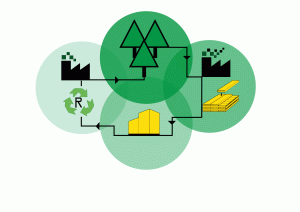Project Summary
The benefits of biogenic carbon storage together with a renewable supply chain mean that greater use of timber, and other plant-based materials, in construction is essential if the UK is to meet its net zero carbon targets by 2050. A GW4 interdisciplinary research community was built between the University of Bristol, University of Bath, University of Exeter and the Cardiff University to investigate the full potential of British-grown timber in the design of affordable and low-energy housing exploring current and future trends (e.g., climate change) in a systems thinking approach bringing together significant expertise in strategic areas such as forestry, architecture, timber engineering, building physics and circular economy.
The objectives of this GW4 research community are to investigate:
- To consider the full potential of British-grown timber in the design of affordable and low-energy housing.
- The thermophysical properties of timber buildings to explore the potential for environmental control.
- Barriers and future possibilities for high-grade engineered wood products in the UK.
- Afforestation strategies, considering climate change effects, and better management of current forestry for commercial timber.
- End-of-life scenarios and ways to increase durability performance to increase opportunities for circular solutions.
Background
Buildings and construction are responsible for approximately 40% of all greenhouse gas emissions. Construction steel and cement production are inherently energy intensive and together account for approximately one third of all industrial CO2 emissions and operational-energy related CO2 emissions from buildings are estimated to be 28% of total anthropogenic emissions in 2018. Meanwhile, the current shortage of homes in England is estimated at 4 million, requiring 350,000 homes to be built annually until 2031. Consequently, to meet these demands and the UK’s net zero targets by 2050, the construction industry must make greater use of sustainable and renewable biomaterials like timber. Despite the environmental benefits of timber, manufacturing (primary and secondary processing) and transportation account for the majority of its embodied carbon and energy. Therefore, it is necessary to optimise the use of timber and focus on local resources and market opportunities and improve timber expertise and current manufacturing methods. Trees sequester biogenic carbon during growth, and this is stored in timber products until end-of-life (around 1.6kCO2e per kg of timber). The longer those products are in-use, the greater the size of the effective carbon sink this creates. Buildings should take priority for timber use, therefore, compared to other more short-lived applications such as packaging or fuel. Timber buildings are related to health and well-being which is opportune with the new remote work culture in the post-COVID era. However, the increasing demand in timber should be well managed with current UK forestry stock and afforestation strategies combined with the effect of climate change in mechanical properties of wood species and other climate-related risks in forestry (e.g., droughts, fires, pests and diseases). Considering current UK Greenhouse Gas Removal afforestation strategies, biodiversity, land management scenarios (e.g., displaced CO2 emissions from reductions in agricultural land) and relevant socioeconomic impacts should be further investigated.





